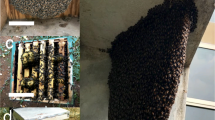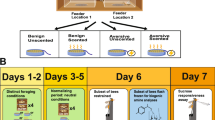Abstract
The concept of a suite of foraging behaviors was introduced as a set of traits showing associative directional change as a characterization of adaptive evolution. I report how naturally selected differential sucrose response thresholds directionally affected a suite of honey bee foraging behaviors. Africanized and European honey bees were tested for their proboscis extension response thresholds to ascending sucrose concentrations, reared in common European colonies and, captured returning from their earliest observed foraging flight. Race constrained sucrose response threshold such that Africanized bees had significantly lower sucrose response thresholds. A Cox proportional hazards regression model of honey bee race and sucrose response threshold indicated that Africanized bees were 29% (P<0.01) more at risk to forage over the 30-day experimental period. Sucrose response threshold organized age of first foraging such that each unit decrease in sucrose response threshold increased risk to forage by 14.3% (P<0.0001). Africanized bees were more likely to return as pollen and water foragers than European foragers. Africanized foragers returned with nectar that was significantly less concentrated than European foragers. A comparative analysis of artificial and naturally selected populations with differential sucrose response thresholds and the common suite of directional change in foraging behaviors is discussed. A suite of foraging behaviors changed with a change in sucrose response threshold that appeared as a product of functional ecological adaptation.





Similar content being viewed by others
References
Allison PD (1998) Survival analysis using the SAS system. A practical guide. SAS Institute, Cary, N.C.
Barron AB, Schulz DJ, Robinson GE (2002) Octopamine modulates responsiveness to foraging-related stimuli in honey bees (Apis mellifera). J Comp Physiol A 188:603–610
Ben-Shahar Y, Robinson GE (2001) Satiation differentially affects performance in a learning assay by nurse and forager honey bees. J Comp Physiol A 187:891–899
Bitterman ME, Menzel R, Feitz A, Schäfer S (1983) Classical conditioning of proboscis extension in honeybees (Apis mellifera). J Comp Psychol 97:107–119
Calderone NW, Page RE (1988) Genotypic variability in age polyethism and task specialization in the honey bee, Apis mellifera (Hymenoptera: Apidae). Behav Ecol Sociobiol 22:17–25
Calderone NW, Page RE (1991) Evolutionary genetics of division of labor in colonies of the honey bee (Apis mellifera). Am Nat 138:69–92
Calderone NW, Page RE (1996) Temporal polyethism and behavioural canalization in the honey bee, Apis mellifera. Anim Behav 51:631–643
Crozier RH, Crozier YC (1992) The cytochrome b and ATPase genes of honeybee mitochondrial DNA. Mol Biol Evol 9:474–482
Danka RG, Hellmich II, Rinderer TE, Collins AM (1987) Diet-selection ecology of tropically and temperately adapted honey bees. Anim Behav 35:1858–1863
Dreller C, Tarpy DR (2000) Perception of the pollen need by foragers in a honeybee colony. Anim Behav 59:91–96
Edgecomb RS, Pyle AR, Murdock LL (1989) The role of water in tarsal thresholds to sugar in the blowfly Phormia regina. J Exp Biol 142:245–255
Fewell JH, Bertram SM (2002) Evidence for genetic variation in worker task performance by African and European honey bees. Behav Ecol Sociobiol 52:318–325
Gary NE, Lorenzen K (1976) A method for collecting the honey-sac contents from honeybees. J Apic Res 15:73–79
Harris JW, Woodring J (1992) Effects of stress, age, season, and source colony on levels of octopamine, dopamine, and serotonin in the honey bee (Apis mellifera L.) brain. J Insect Physiol 38:29–35
Hartz SM, Ben-Shahar Y, Tyler M (2001) Logistic growth curve analysis in associative learning data. Anim Cogn 4:185–189
Hoffmann AA, Parsons PA (1994) Evolutionary genetics and environmental stress. Oxford University Press, New York
Hunt GE, Collins AM, Rivera R, Page RE, Guzman-Novoa E (1999) Quantitative trait loci influencing honeybee alarm pheromone levels. J Hered 90:585–589
Menzel R, Heyne A, Kinzel C, Gerber B, Fiala A (1999) Pharmacological dissociation between the reinforcing, sensitizing, and response-releasing functions of reward in honeybee classical conditioning. Behav Neurosci 113:744–754
Page RE, Erber J, Fondrk MK (1998) The effect of genotype on response thresholds to sucrose and foraging behavior of honey bees (Apis mellifera L.). J Comp Physiol A 182:489–500
Pampel FC (2000) Logistic regression. A primer. Sage, Thousand Island Oaks, Calif.
Pankiw T, Page RE (1999) The effects of genotype, age, and caste on response thresholds to sucrose and foraging behavior of honey bees. J Comp Physiol A 185:207–213
Pankiw T, Page RE (2000) Response thresholds to sucrose predict foraging division of labor in honey bees. Behav Ecol Sociobiol 47:265–267
Pankiw T, Page RE (2001) Genotype and colony environment affect honey bee (Apis mellifera L.) development and foraging behavior. Behav Ecol Sociobiol 51:87–94
Pankiw T, Rubink WL (2002) Pollen foraging response to brood pheromone by Africanized and European honey bees (Apis mellifera L.). Ann Entomol Soc Am 95:761–767
Pankiw T, Waddington. KD, Page RE (2001) Modulation of sucrose response thresholds in honey bees (Apis mellifera): influence of genotype, feeding and foraging experience. J Comp Physiol A 187:293–301
Pankiw T, Tarpy DR, Page RE (2002) Genotype and rearing environment affect honeybee perception and foraging behaviour. Anim Behav 64:663–672
Reznick DN, Ghalambor CK (2001) The population ecology of contemporary adaptations: what empirical studies reveal about the conditions that promote adaptive evolution. Genetica 112–113:183–198
Rubink WL, Luévano-Martínez P, Sugden EA, Wilson WT, Collins AM (1996) Subtropical Apis mellifera (Hymenoptera: Apidae) swarming in dynamics and Africanization in northeastern Mexico and southern Texas. Ann Entomol Soc Am 89:243–251
SAS (2000) The SAS system version 8.01. SAS Institute, Cary, N.C.
Scheiner R, Page RE, Erber J (2001a) The effects of genotype, foraging role and sucrose responsiveness on the tactile learning performance of honey bees (Apis mellifera L.). Neurobiol Learn Mem 76:138–150
Scheiner R, Page RE, Erber J (2001b) Responsiveness to sucrose affects tactile and olfactory learning in preforaging honey bees of two genetic strains. Behav Brain Res 120:67–73
Schneider SS, McNally LC (1993) Spatial foraging patterns and colony energy status in the African bee, Apis mellifera scutellata. J Insect Behav 6:195–210
Schulz DJ, Robinson GE (2001) Octopamine influences division of labor in honey bee colonies. J Comp Physiol A 187:53–61
Sokal RR, Rohlf FJ (1995) Biometry. The principles and practice of statistics in biological research, 3rd edn. Freeman, New York
Sugden EA, Williams KR (1990) October 15: the day the bee arrived. Glean Bee Cult 119:18–21
Winston ML, Katz SJ (1982) Foraging differences between cross-fostered honeybee workers (Apis mellifera) of European and Africanized races. Behav Ecol Sociobiol 1:125–129
Winston ML, Taylor O, Otis GW (1983) Some diffferences between temperate European and tropical African and South American honeybees. Bee World 64:12–21
Acknowledgements
Thanks are extended to W.L. Rubink for supplying Africanized queens, and two anonymous reviewers for constructive criticism that improved this manuscript. This project was supported by funds from the Texas Honey Bee Initiative and USDA 58-6204-8-093. Bees were handled in compliance with current laws of the United States of America.
Author information
Authors and Affiliations
Corresponding author
Additional information
Communicated by R.F.A. Moritz
Rights and permissions
About this article
Cite this article
Pankiw, T. Directional change in a suite of foraging behaviors in tropical and temperate evolved honey bees (Apis mellifera L.). Behav Ecol Sociobiol 54, 458–464 (2003). https://doi.org/10.1007/s00265-003-0640-1
Received:
Revised:
Accepted:
Published:
Issue Date:
DOI: https://doi.org/10.1007/s00265-003-0640-1




